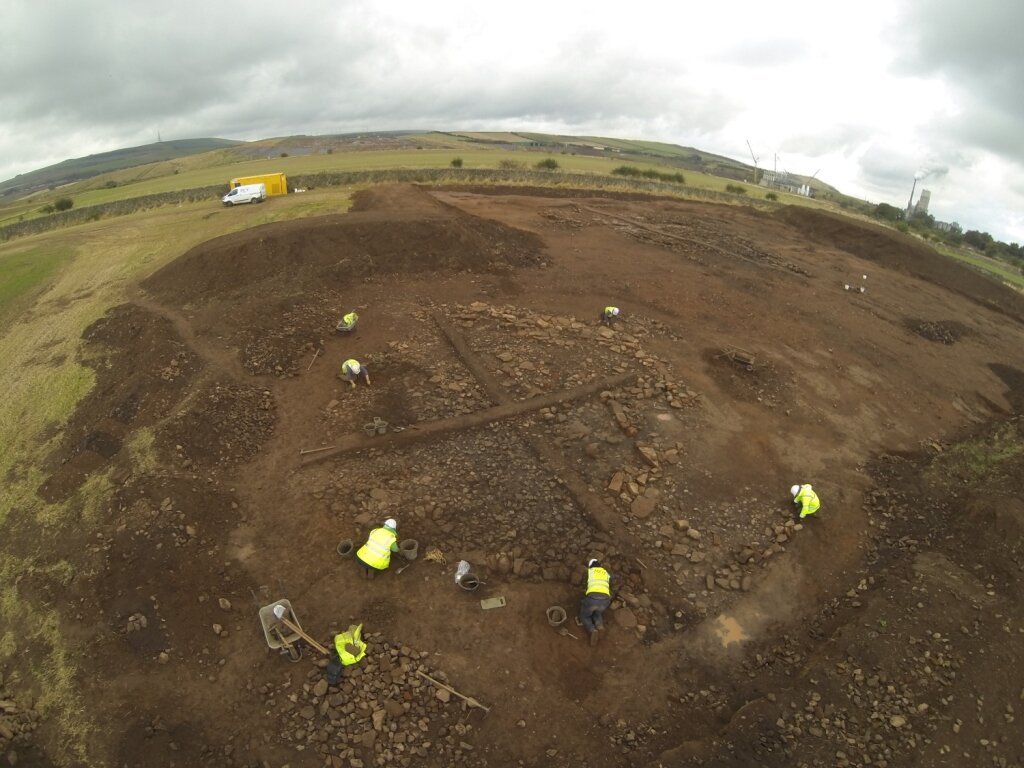Shedding Light on the Iron Age in East Lothian
Since early September 2016, AOC has been working on an Iron Age site at the Tarmac Quarry at East Barns, near Dunbar, East Lothian. Evaluation trenching in 2003 identified a possible double walled stone built roundhouse and courtyard area, but it is only now, over a decade later, that the active quarry works are approaching the area in which these remains were identified. Complete excavation was required to ensure that no information was lost. A topsoil strip of the site revealed an area of stone tumble covering approximately 35m by 30m and a second area to the northeast some 20m by 16m. Careful removal of this tumble revealed that the main area comprised five round structures of varying size and constructions. Four of these structures had direct stratigraphic relationships, allowing us to establish a chronology for the site.
The earliest structure, Structure 1, is almost 8m in diameter with a cobble floor, and walls standing up to five courses high. This is truncated on the western side by Structure 2, a double-walled roundhouse with a flagstone floor and an extensive flagstone courtyard to the east, which partially overlay Structure 1. Structure 2 had an internal diameter of nearly 5 m and external diameter of 7.5 m, with a clear east-facing entrance. Structure 3 was built directly over Structure 2 and made use of the earlier flagstone courtyard as its floor. Structure 3 comprised a large double-faced wall, more substantial than that of Structure 2. It would appear the remains of Structure 2 were appended to Structure 3. Structure 3 was truncated by the western side of Structure 4, a small single-walled roundhouse. Structure 4 measured about 5 m in diameter with a flagstone floor which covered an earlier cobble floor with a cobbled east-facing entrance. To the north of these structures there was another small roundhouse, Structure 5 as well as further sections of stone wall, a flagstone pathway and a stone revetment. Underlying these remains were some shell middens and cut pit features. A range of artefacts was recovered, including a bronze Fibulae brooch, a bronze dumbell toggle and numerous coarse stone items including rotary querns, stone balls, stone bowls and pottery.
The second area to the northeast comprised a single sub-circular partially sunk structure which revealed a series of cobble and partial flagstone surfaces overlying an earlier metalled surface. No postholes were evident, though the partial remains of a ring-groove cut through the metalled surface were identified. This single structure yielded a wealth of artefacts including about a dozen rotary querns, three spindle whorls, two possible ingot moulds, a whetstone and numerous other cobble tools. Also discovered were quantities of animal bone and red deer antler, including many examples displaying butchery and tool marks.
Work at East Barns is ongoing and we have much more to learn about the site, with excavation planned to continue in January 2017. In due course, a comprehensive post-excavation programme including scientific dating and analysis of the artefacts and ecofacts, will help shed light on the lives of those who lived at East Barns in prehistory. It will be interesting to see how the site at East Barns compares to the extensive Iron Age remains of Broxmouth Hillfort which lies less than a kilometre to the west. It too had double walled stone built roundhouses, and the material culture of Broxmouth is closely matched by the artefacts recovered at East Barns.
Work at East Barns is being undertaken on behalf of Tarmac.



